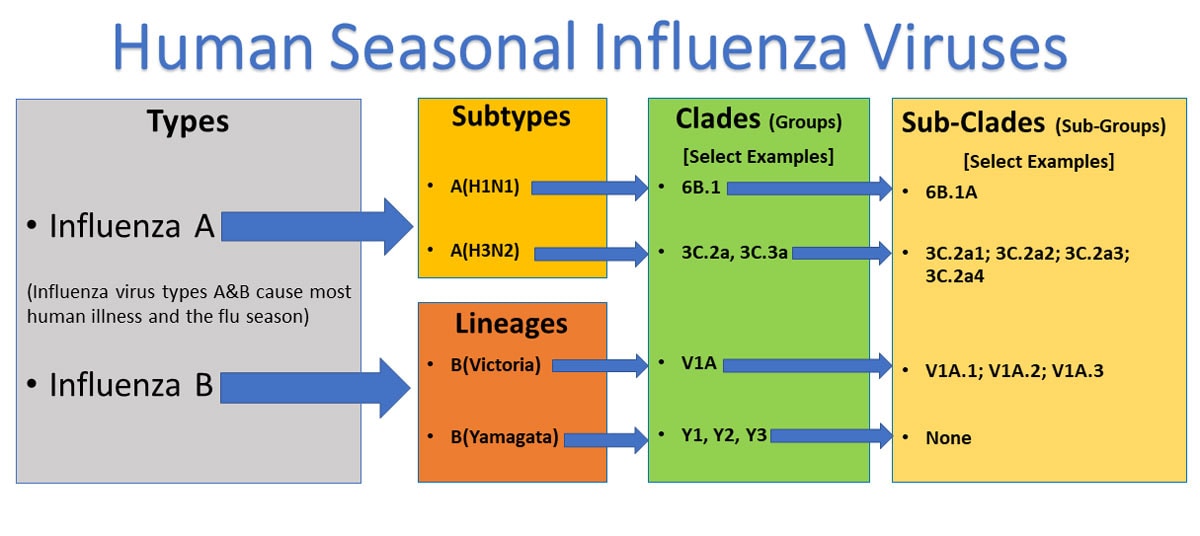Influenza (Flu) Overview
The flu, also called influenza, is a respiratory infection caused by viruses. Flu attacks the respiratory system, your nose, throat and lungs. Each year, millions of people around the world get sick with the flu.
Sometimes it causes mild illness. But it can also be serious or even deadly, especially for people over 65, newborn babies, and people with certain chronic illnesses.
For most people, the flu resolves on its own. But sometimes, influenza and its complications can be deadly in certain individuals.
Although the annual influenza vaccine isn’t 100% effective, it’s still your best defense against the flu. According to the Centers for Disease Control and Prevention (CDC) flu vaccination reduces the risk of flu illness by between between 40% and 60% among the overall population during flu season.
Following individuals are at higher risk of developing flu complications:
- Young children under age 5, and especially those under 6 months
- Senior citizens older than age 65
- Residents of nursing homes and other long-term care facilities
- Pregnant women and women up to two weeks after giving birth
- Individuals with weakened immune systems immune system
- Native Americans
- Patients who have chronic illnesses, such as asthma, heart disease, kidney disease, liver disease and diabetes
- People who are very obese, with a body mass index (BMI) of 40 or higher
Signs and Symptoms of Influenza (Flu)
Initially the flu may seem like a common cold with a runny nose, sneezing and sore throat. But colds usually develop slowly, whereas the flu tends to come on suddenly. With the flu you usually people feel much worse with the cold.
Following are the common signs and symptoms of Influenza (flu):
- Fatigue
- Fever above 100 F
- Aching muscles and joints
- Chills and sweats
- Diarrhea (common in children)
- Headache
- Indigestion
- Persistent dry cough
- Red watery eyes
- Shortness of breath
- Tiredness
- Runny or stuffy nose
- Sore throat
- Eye pain
- Vomiting (common in children)
- Warm, flushed skin
- Weakness
Patients should get medical help right away if they have the following conditions:
- Confusion
- Trouble breathing or shortness of breath
- Sudden Dizziness
- Pain or pressure in your chest or belly
- Severe Vomiting
Influenza (Flu) vs Cold Symptoms
The signs and symptoms of influenza (flu) and cold can be similar, following are some of the differences between influenza (flu) and cold:
- Aches: Body aches may be severe with the flu; they’re mild with a cold.
- Chills: Chills are more likely with the flu, but they’re rare with a cold.
- Cough and chest discomfort: This is common with both but tends to be severe with the flu.
- Fever: Fever can last 3 or 4 days with the flu; fever is rare with a cold.
- Fatigue: Fatigue is common with the flu and can sometimes happen with a cold.
- Headache: Headaches are common when you have the flu but rare with a cold.
- Sore throat: Sore throat can be common with the flu but is more likely with a cold.
- Sneezing: Sneezing is more likely with a cold than with the flu.
- Stuffy nose: Stuffy nose sometimes happens with the flu but is common with a cold.
Types of Influenza (Flu)
There are four types of influenza (flu) viruses:
-
Type-A
-
Type-B
-
Type-C
-
Type-D
There are four types of influenza viruses: A, B, C and D. Human influenza A and B viruses cause seasonal epidemics of disease (known as flu season) almost every winter in the United States.
Influenza A viruses are the only influenza viruses known to cause flu pandemics, i.e., global epidemics of flu disease. A pandemic can occur when a new and different influenza A virus emerges that both infects people and has the ability to spread efficiently among people.
Infections influenza C virus generally cause mild illness and are not thought to cause human epidemics. Influenza D viruses primarily affect cattle and are not known to infect or cause illness in people.
Influenza A viruses are divided into subtypes based on two proteins on the surface of the virus: hemagglutinin (H) and neuraminidase (N). There are 18 different hemagglutinin subtypes and 11 different neuraminidase subtypes (H1 through H18 and N1 through N11, respectively).
While more than 130 influenza A subtype combinations have been identified in nature, primarily from wild birds, there are potentially many more influenza A subtype combinations given the propensity for virus “re-assortment.” Re-assortment is a process by which influenza viruses swap gene segments.
Re-assortment can occur when two influenza viruses infect a host at the same time and swap genetic information. Current subtypes of influenza A viruses that routinely circulate in people include: A(H1N1) and A(H3N2).
Influenza A subtypes can be further broken down into different genetic “clades” and “sub-clades.” See the “Influenza Viruses” graphic below for a visual depiction of these classifications.

This graphic shows the two types of influenza viruses (A and B) that cause most human illness and that are responsible for flu seasons each year.
Influenza A viruses are further classified into subtypes, while influenza B viruses are further classified into two lineages: B/Yamagata and B/Victoria. Both influenza A and B viruses can be further classified into clades and sub-clades (which are sometimes called groups and sub-groups.)
The influenza A and B viruses that routinely spread in people (human influenza viruses) are responsible for seasonal flu epidemics each year.
Causes of Influenza (Flu)
Influenza viruses travel through the air in droplets when someone with the infection coughs, sneezes or talks. You can inhale the droplets directly, or you can pick up the germs from an object, such as a telephone or computer keyboard, or other things you come into contact with or touch and then transfer them to your eyes, nose or mouth.
Individuals with the virus are likely to be contagious from about one day before symptoms appear until about five days after they start. Children and people with weakened immune system may be contagious for a slightly longer time.
Influenza viruses are constantly changing, with new strains appearing regularly. If you’ve had influenza in the past, your body has already made antibodies to fight that specific strain of the virus.
If future influenza viruses are similar to those you’ve encountered before, either by having the disease or by getting vaccinated, those antibodies may prevent infection or lessen its severity. But antibody levels may decline over time.
Also, antibodies against influenza viruses you’ve encountered in the past may not protect you from new influenza strains that can be very different viruses from what you had before.
Risk Factors of Influenza (Flu)
Following factors may increase the risk of developing the flu or its complications:
- Age: Seasonal influenza usually targets children 6 months to 5 years old, and adults 65 years old or older.
- Aspirin use under age 19: People who are younger than 19 years of age and receiving long-term aspirin therapy are at risk of developing Reye’s syndrome if infected with influenza.
- Chronic illnesses: Chronic conditions, including lung diseases such as asthma, diabetes, heart disease, nervous system diseases, metabolic disorders, an airway abnormality, and kidney, liver or blood disease, may increase the risk of influenza complications.
- Living or working conditions: People who live or work in facilities with many other residents, such as nursing homes or military barracks, are more likely to develop the flu. People who are staying in the hospital also are at higher risk.
- Obesity: People with a body mass index (BMI) of 40 or more have an increased risk of flu complications.
- Pregnancy: Pregnant women are more likely to develop influenza complications, particularly in the second and third trimesters. Women are more likely to develop influenza-related complications up to two weeks after delivering their babies.
- Race: Native American people may have an increased risk of influenza complications.
- Weakened immune system: Cancer treatments, anti-rejection drugs, long-term use of steroids, organ transplant, blood cancer or HIV/AIDS can weaken the immune system. This can make it easier to catch the flu and may also increase the risk of developing complications.
Complications of Influenza (Flu)
Individuals who are otherwise healthy, usually don’t have serious problems from the flu. Pneumonia is one of the most serious complications. For older adults and patients with a chronic illness, pneumonia can be deadly.
Following are some of the complications of Influenza (Flu):
- Asthma
- Acute Respiratory Distress Syndrome (ARDS)
- Brain Inflammation (encephalitis)
- Bronchitis
- Chronic heart disease flare-ups
- Ear infection
- Heart Inflammation (myocarditis)
- Muscle aches
- Organ failure
- Sinus infection
- Pneumonia
Prevention of Influenza (Flu)
The Centers for Disease Control and Prevention (CDC) recommends annual flu vaccination for everyone age 6 months or older. The flu vaccine can reduce your risk of the flu and its severity and lower the risk of having serious illness from the flu and needing to stay in the hospital.
Flu vaccination is especially important because the flu and coronavirus disease 2019 (COVID-19) cause similar symptoms. Flu vaccination could reduce symptoms that might be confused with those caused by COVID-19 pandemic.
Preventing the flu and reducing the severity of flu illness and hospitalizations could also lessen the number of people needing to stay in the hospital.

Bay Biosciences is a global leader in providing researchers with high quality, clinical grade, fully characterized human tissue samples, bio-specimens, and human bio-fluid collections.
Samples available include cancer (tumor) tissue, cancer serum, cancer plasma, cancer, peripheral blood mononuclear cells (PBMC). and human tissue samples from most other therapeutic areas and diseases.
Bay Biosciences maintains and manages its own biorepository, the human tissue bank (biobank) consisting of thousands of diseased samples (specimens) and from normal healthy donors available in all formats and types.
Our biobank procures and stores fully consented, deidentified and institutional review boards (IRB) approved human tissue samples and matched controls.
All our human tissue collections, human specimens and human bio-fluids are provided with detailed, samples associated patient’s clinical data.
This critical patient’s clinical data includes information relating to their past and current disease, treatment history, lifestyle choices, biomarkers, and genetic information.
Patient’s data is extremely valuable for researchers and is used to help identify new effective treatments (drug discovery & development) in oncology, and other therapeutic areas and diseases.
Bay Biosciences banks wide variety of human tissue samples and biological samples, including cryogenically preserved at – 80°C.
Including fresh frozen tissue samples, tumor tissue samples, formalin-fixed paraffin-embedded (FFPE), tissue slides, with matching human bio-fluids, whole blood and blood-derived products such as serum, plasma and PBMC.
Bay Biosciences is a global leader in collecting and providing human tissue samples according to the specified requirements and customized, tailor-made collection protocols.
Please contact us anytime to discuss your special research projects and customized human tissue sample requirements.
Bay Biosciences provides human tissue samples (human specimens) from diseased and normal healthy donors which includes:
- Peripheral whole-blood
- Amniotic fluid
- Bronchoalveolar lavage fluid (BAL)
- Sputum
- Pleural effusion
- Cerebrospinal fluid (CSF)
- Serum (sera)
- Plasma
- Peripheral blood mononuclear cells (PBMC)
- Saliva
- Buffy coat
- Urine
- Stool samples
- Aqueous humor
- Vitreous humor
- Kidney stones (renal calculi)
- Other bodily fluids from most diseases including cancer.
We can also procure most human bio-specimens, special collections and requests for human samples that are difficult to find. All our human tissue samples are procured through IRB-approved clinical protocols and procedures.
In addition to the standard processing protocols, Bay Biosciences can also provide human plasma, serum, and PBMC bio-fluid samples using custom processing protocols; you buy donor-specific collections in higher volumes and specified sample aliquots from us.
Bay Biosciences also provides human samples from normal healthy donors; volunteers, for controls and clinical research, contact us Now.
日本のお客様は、ベイバイオサイエンスジャパンBay Biosciences Japanまたはhttp://baybiosciences-jp.com/contact/までご連絡ください。

